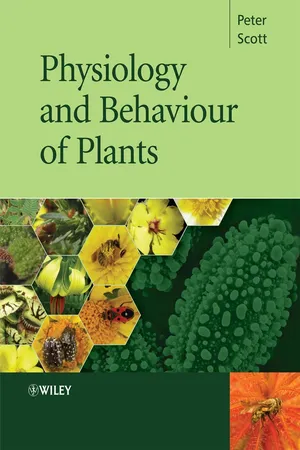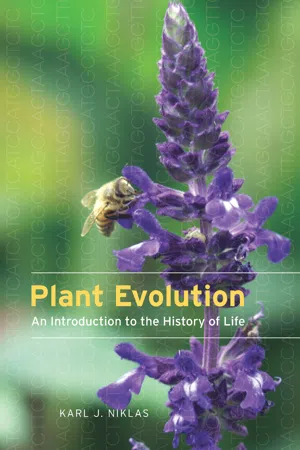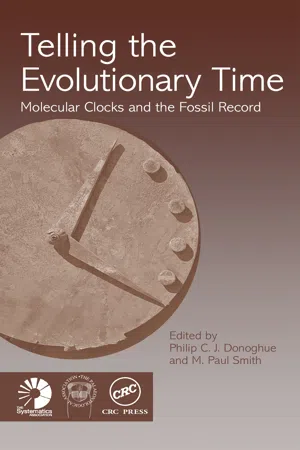Biological Sciences
Plant Timeline Evolution
The plant timeline evolution refers to the gradual development and diversification of plant life over millions of years. It encompasses the emergence of key plant groups, such as bryophytes, ferns, gymnosperms, and angiosperms, and their adaptation to various environmental conditions. This evolutionary process has led to the vast array of plant species that exist today, each with unique characteristics and ecological roles.
Written by Perlego with AI-assistance
Related key terms
5 Key excerpts on "Plant Timeline Evolution"
- eBook - ePub
- Peter Scott(Author)
- 2013(Publication Date)
- Wiley-Interscience(Publisher)
1Introducing plants
In this chapter, we look at how plants originated, what floral diversity there is today and the make-up of the plant and its ultrastructure.The beginning: the evolution of plants and the major divisions
In the beginning, it is most probable that plants evolved from photosynthetic bacteria. From these bacteria the red and green algae evolved; and from freshwater-dwelling green algae the simple lower plants, such as mosses and ferns, evolved; and so on, up to the higher plants. A phylogenetic tree is shown in Figure 1.1 and Table 1.1 to demonstrate the relationship between the members of the plant kingdom and their relative abundance through the history of the planet.Figure 1.1 Schematic diagram of the phylogeny of plants. The diagram shows the evolutionary relationship between the different species and the relative abundance in terms of species numbers (shown by the width of the dark red lineage tree). On the y axis the different time periods of the evolutionary history of plants are shown. The diagram is based on that presented by Ridge 2002.Table 1.1 Estimates of numbers of species occurring in plant divisions.
These estimates are based on there being around 260 000 different species of plant in the world. Species of plants based on data from Ridge 2002.Plant division Common name Approximate number of species Hepatophyta Liverworts 6000 Anthocerophyta Hornworts 100 Bryophyta Mosses 10 000 Lycophyta Club mosses and quillworts 1000 Tree lycopods Extinct Psilotum Whisk fern 3 Equisetum Horsetail 15 Pterophyta Ferns 11 000 Peltasperms Seed ferns Extinct Progymnosperms Extinct Cycadophyta Cycads 140 Ginkophyta Maidenhair tree 1 Coniferophyta Confers 550 Gnetophyta Vessel-bearing gymnosperms 70 Angiosperms Flowering plants 23 5000 Conquering the land
The origin of plants was in water, where both photosynthetic bacteria and then algae originated. Light penetration of water reduces with depth, and on average only 1% of incident light reaches to a depth of over 15 m. As a consequence, there is a body of water at the surface known as the photic zone, where all of the photosynthetic activity in oceans occurs. A great deal of this photosynthetic activity still occurs at the shores of the oceans, where more complex algae have evolved; as a group these are commonly referred to as seaweeds. Algae are restricted to the oceans and freshwater bodies since, as part of the life cycle of algae, gametes (sex cells) that swim through water are required for sexual reproduction. This is thought to have been a major hindrance to plants attempting to colonize the land surface of the Earth and to overcome this, new reproductive systems needed to evolve. - eBook - ePub
Plant Evolution
An Introduction to the History of Life
- Karl J. Niklas(Author)
- 2016(Publication Date)
- University of Chicago Press(Publisher)
2 The Invasion of Land and Air A tale, like the universe, they tell us, expands ceaselessly each time you examine it, until there’s finally no telling exactly where it begins, or ends, or where it places you now. —CHANG-RAE LEE, On Such a Full Sea (2014) The previous chapter was devoted to evolutionary events occurring in the Precambrian. Here, we turn attention to critical events that occurred in the time interval called the Phanerozoic, although it is just as appropriate to call this time span the Phanerophytic (fig. 2.1). Compared with the early events in life’s history, the events in this period may appear less dramatic or important. Yet, four evolutionary events changed the biological world dramatically. These were the invasion of land, the evolution of conducting tissues, the appearance of the first seed plants, and the evolution of the flowering plants. The first organisms to live and reproduce on land were eukaryotic photosynthetic organisms (plants) and lichen-like organisms, and, by providing shelter and food, they paved the way for the invasion of the land by animals. Those of us who study plants can take solace in the fact that the first zoological landfall was contingent on the greening of the terrestrial landscape by plants, which was really more an invasion of air than of land. Many organisms can live in the wet interstices of soil and rock, but the first to challenge and later subdue the air were plants. Life’s onslaught on air involved the evolution of vascular tissues, which provide low-resistance conduits for the flow of water and food. Without these plant tissues all terrestrial life, animals as well as plants, would remain physiologically anchored to a semiaquatic existence. The final greening of the land required seeds. Seed plants can successfully reproduce as well as survive vegetatively even in the most arid habitats, and so they have radiated into the drier uplands and deserts of the Earth - eBook - ePub
- Donald Kaplan, Chelsea D. Specht(Authors)
- 2022(Publication Date)
- CRC Press(Publisher)
Given the prolonged embryonic activity and developmental plasticity that plants exhibit as well as the lack of a clear demarcation into juvenile and adult phases that many species show, it may not be possible to squeeze plants into these animal models. Before we start applying these developmental evolutionary concepts to plants will have to know a great deal more about the phylogeny and comparative developmental mechanisms underlying structural variability in plants than we know now. It is interesting that attempts by botanists to apply these models of heterochrony to the interpretation of the evolution of plant form to date have been restricted to the study of determinate organs and organ systems, such as flowers and leaves, which have a finite ontogeny and determination, resembling whole animal development (Guerrant, 1982 ; Lord, 1982 ; Hill and Lord, 1986). Thus they have focused only on what we have termed organogenesis and not on the true ontogeny of whole plants. Until we have a clearer conception of how ontogeny and organogenesis are related in plants, we cannot say whether these heterochronic models have any applicability. Up to this point in this book we have given an overview of how plant organization has its inception during ontogeny and what the broad outlines of plant ontogeny are. From our paradigm of relating evolution to plant development it is clear that we now need to make a more detailed analysis of the bases of ontogenetic change in plant form as expressed by its organogenesis. Hence the next and largest section of the book deals with the developmental basis of variability in the major organ systems. After we have completed that treatment, we will put these elements back together in comparing ontogenies of plants that exhibit different life forms in relation to different habitats - eBook - ePub
- Andrew Lack, David Evans(Authors)
- 2021(Publication Date)
- Taylor & Francis(Publisher)
mass extinctions among plants. This is likely to be because plants are inherently more resistant to rapid upheavals since they have simple nutrient requirements, long lives and potentially numerous dormant seeds and wide dispersal.There have been four major adaptive radiations of land plant groups: the first land plants; the ferns and their allies; the gymnosperms; and the angiosperms. Each radiation appears to have been stimulated by major continental changes (coalescence or break up) and especially by the presence of large land masses at low latitudes and by a wide range of topography. The radiations are also associated with times of increased carbon dioxide concentration and a warmer, wetter climate. The three factors go together since continental changes can stimulate volcanic activity and this can increase CO2 concentration which itself changes the climate (Topic L6). Ocean currents will also change, exaggerating or reducing climate change. Increasing CO2 is known experimentally to enhance growth and affect plant reproduction leading to shorter lifespans, and alleviate stresses that may come from other sources, e.g. toxic substances. Warmer moister environments over more of the globe allow a greater area to be colonized.Over millions of years after an upheaval, plants reduce the quantity of atmospheric CO2 , because some plant material does not fully decay and is laid down as peat or undecayed wood that eventually fossilizes as coal or oil. This leads to a drier, cooler environment with greater differentiation between equator and poles. In the late Devonian, when the ferns and earliest seed plants were increasing and actively evolving, the CO2 levels were nearly 10 times what they are today, to decline to present-day levels by the end of the Carboniferous. Further increases by late Triassic and again in mid-Cretaceous times to about four times today’s level were followed by adaptive radiations in gymnosperms and angiosperms respectively. Each radiation has coincided with a steady loss of the previously dominant groups, although living relatives remain. Currently CO2 concentration is low, though rising with industry, and the climate is generally arid and showing marked contrast from equator to poles. Angiosperms are better suited to this than gymnosperms, themselves better than ferns, a factor contributing to the general dominance of angiosperms except in boreal environments. C4 and CAM metabolism are the newest adaptations to low CO2 - eBook - ePub
Telling the Evolutionary Time
Molecular Clocks and the Fossil Record
- Philip C J Donoghue, M. Paul Smith(Authors)
- 2003(Publication Date)
- CRC Press(Publisher)
Chapter 7Dating the origin of land plants
Charles H.Wellman
ABSTRACTAscertaining the time of origin of land plants has been a long standing scientific concern. Initial estimates were based on the early land plant megafossil record, and suggested a late Silurian origin. However, the megafossil record is notoriously poor, and subsequent work on the early land plant dispersed microfossil record (spores and phytodebris) indicates an earlier origin, in the Llanvirn (Ordovician). The disparity between the plant megafossil/microfossil record is believed to be largely a consequence of the low preservation potential of the earliest land plants: these are considered to have been bryophyte-like, and most likely lacked recalcitrant tissues, such as those containing lignin, that facilitate preservation as megafossils. More recently, other techniques have been employed to shed light on the time of origin of land plants. The geochemical record has been examined for signals reflecting global change considered to have been concomitant with the developmental of a significant terrestrial vegetation. Such techniques are, however, fraught with difficulties. Assessing the extent and pattern of global change associated with the development of terrestrial vegetation is largely conjectural. Furthermore, the relationships between global change and geo-chemical signals are often poorly understood. Another approach has been the utilization of molecular clock techniques. Recent molecular clock analyses suggest that land plants diverged significantly earlier than expected based on fossil evidence. However, concern has been expressed that many of the currently utilized molecular clock techniques are flawed, and indeed that the molecular clock does not exist. None the less, research into molecular clocks is still in its infancy, and there is hope that, ultimately, more reliable techniques will appear that will engender greater confidence in results. It is argued here that currently the most reliable estimate for the time of origin of land plants remains the minimum estimate of Llanvirn (Ordovician) provided by the early land plant dispersed microfossil record. In future this benchmark may well be breached as new fossil finds and new techniques (possibly refined molecular clock techniques) come to light.
Learn about this page
Index pages curate the most relevant extracts from our library of academic textbooks. They’ve been created using an in-house natural language model (NLM), each adding context and meaning to key research topics.




